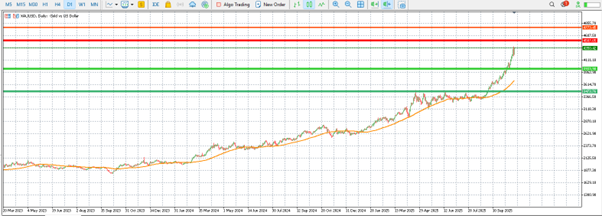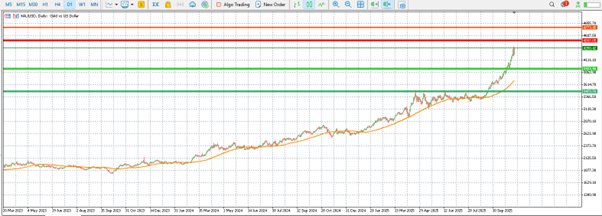Gold has recently entered perhaps the most volatile period ever witnessed, with intraday swings increasing by several hundred dollars and eventually closing the week substantially higher, albeit with a last-minute retracement. Spot prices, up to Monday, October 20, are settling around newfound highs of around $4,250 per ounce, following a week that saw gains above 10% and single-day movements around $200, with traders wrestling with a cocktail of tariff spats, a protracted United States government shutdown, and expectations for an interest rate reduction at the Federal Reserve's gathering next week, October 28–29.

Gold price chart by XTB
What Truly Made Gold Move the Past Week
1) Tariff Shock → "Walk-Back"
The catalyst was trade war risk roaring back to the fore. President Trump vowed an extra 100% tariff on imports from China—specifically noting such a rate isn't "sustainable"—before indicating the ultimate number will indeed be lower. Markets traded the build-out and then the partial retreat over the course of a day, producing a typical safe-haven surge followed by a relief erosion. The net result: increased volatility and a higher floor for gold as traders priced in tail risk surrounding supply chain dynamics, growth, and inflation spillovers.
2) Shutdown as a risk amplifier
The U.S. federal government is closed for the fourth week. In addition to the direct blow to the flow of data and confidence, news that vital agencies are operating skeleton shifts has underpinned the appeal for hedges. Despite hopes that a compromise might materialise this week, the duration of the shutdown has left safe-haven demand adherent. Simply: each hour the Washington lights remain lowered, gold retains a geopolitical, policy-uncertainty premium.
3) The Fed’s Setup: Easing Bias into Late October
The calendar is doing a favor for gold. The Federal Open Market Committee convenes on October 28 and 29, with markets leaning toward at least a 25 basis points cut, as the narrative is largely shaped by softer labor signals and a desire to support growth. The closer we draw to the decision, the more any unexpected negative data or shocks in risk assets bolster dovish expectations—and enhance gold’s allure.
4) Dollar and Cross-Asset Environment
Late in the week, the dollar's strength took some of the day's highs away from gold, but even that couldn't diminish the overall surge. Silver surged along—with momentarily printing all-time highs—before experiencing a shakeout. That then confirmed that the week's advance wasn't merely macro hedging but also momentum and CTA flows onto the tape. Net-net, the spillovers from FX and positioning aided to create those gigantic $100–$200 bars witnessed last Friday.
5) China Growth Fears and Rare-Earth Strains
In addition to the headline price of the tariff, investors were concerned about the underlying erosion within U.S.–China relations—particularly technology and minerals. When the world's two largest economies talk escalation (then threaten to talk), gold gets a two-way bid: fear higher, relief bounces lower—albeit with a net safe-haven premium that, so far, has held.
How Far Can This Run?
Imagining it in scenarios helps:
Base Case (Still Elevated, Choppy Uptrend): $4,150–$4,450 Near Term
If the shutdown prolongs through the end of week and the Fed indicates an easing direction aligned with pricing, gold can remain above $4,200 and test the higher end of last week's ranges. The catalyst is not simply rates, but rather policy haze. Consider "buy dips, fade blow-offs" as liquidity holes generate those $50–$150 intraday ranges.
Bull Case (New Spike Highs): Surpassing $4,500 amidst Astonishing Headlines.
A new tariff escalation (even if later "clarified"), a disorderly data surprise surrounding the shutdown, or an unexpectedly deeper cut could force a new squeeze. Momentum funds and system funds would chase, with silver volatility being an accelerant.
Bear Case (Controlled Cool-Off): $4,000–$4,150
A credible Washington compromise to settle the government shutdown ahead of the Fed, upbeat U.S.–China visuals, and a slightly stronger dollar might drain the fear premium and invite profit-taking. With the magnitude of the previous advance, a $150–$250 retracement wouldn't break the larger bullish trend but would keep the daily fireworks under wraps.
What can halt the momentum of the "Shining Metal"?
A Shutdown Resolution—Before the Fed
If the House passes a clean stopgap that reopens the agencies and restores the flow of information, then one of gold's critical pillars—policy uncertainty—will be taken away. With higher-than-expected delayed releases, the safe-haven appeal is negated, at least tactically.
A Hawkish Surprise at the FOMC
Markets are already dovish. If Chair Powell reduces sequential reductions, highlights data dependence, or expresses worries about inflation stickiness, real yields might reverse and weigh on bullion—although the Fed is still reducing 25 bps. It's the direction that is more important than the print.
The bottom line: last week’s surge was fundamentally about policy risk premia—trade, governance, and rates—stacking in the same direction. Until at least one of those pillars is removed, gold retains an elevated floor and the capacity for outsized daily bars. When clarity arrives—be it a shutdown deal, tariff thaw, or a firmer Fed path—expect the “shining metal” to cool from a boil to a simmer. For now, volatility is the feature, not the bug.
